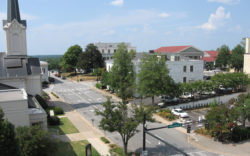Frat House: Sigma Chi has been quietly working on plans for a big new fraternity house that they’d like to build at 340 N. Milledge Ave. (between Meigs Street and Hancock Avenue), despite significant opposition from the neighborhood, including some alumni members of the fraternity. Although the site has a Milledge address, it’s many blocks away from the fraternity and sorority row of South Milledge, in the much quieter Cobbham neighborhood. The area has already been hit by one unwelcome fraternity, Kappa Alpha, which found the historically black Reese and Pope neighborhood nearby to be an appropriate site for its plantation house-inspired dormitory, and neighbors are right to fear this becoming a pattern.

Chi Phi forced its way onto Milledge Avenue in spite of neighborhood opposition. Will Sigma Chi do the same?
Neighborhood residents have already retained a land-use attorney to help them in the fight against the proposal. Of course, the Chi Phi fraternity on the other end of Milledge got its way (with the invaluable assistance of county staff) by holding the threat that something much worse could be built over Commissioners’ heads, so lawyering up is probably a smart move for neighbors of the site currently in question.
Is this yet another case of out-of-town alumni deciding what’s best for the community and its residents simply because they donate money and come back a few times a year for football games? It sounds an awful lot like arguments the Selig team has made; in support of its request for carte blanche on the future of downtown Athens, the firm was eager to mention money donated to the university and that a parking lot near the Coliseum bears its name.
Of course, this problem wouldn’t exist if the university weren’t actively pushing these fraternities off campus. Sigma Chi is the last holdout on Lumpkin Street, where a row of fraternity houses once stood, which is now slated for a big new expansion of the Terry College of Business. There is, of course, still space in the River Road fraternity row, but the university’s reputation as a landlord for fraternities is untrustworthy to those kicked off or bought out.
Perhaps the pending retirement of President Michael Adams will open up a more flexible chapter in campus planning that will actually allow these student communities to live on campus. Frat houses are but one of many town-gown issues that need more planning and more partnership to move past adversarial battles. As the economy heats back up, the construction of student housing is ramping back up. Even the current conflict over a tree in Normaltown and infill housing there is only the first of many battles that neighborhood will face as the University Health Sciences Campus gets going. A veterinary teaching hospital is slated for College Station Road, and retains many sites for future growth. Hopefully, UGA’s next president will be prepared to work with local citizens proactively as the university aggressively spreads its influence into so many different parts of town.
Dollar Stores: A Family Dollar store is under construction at Baxter and Rocksprings, at the former location of Fook’s Foods, and a Dollar General is proposed a few blocks away, at Broad and Chase. It’s an interesting proliferation, and I wonder if we’ll start to see more of these infill general stores throughout town. The one being built on Baxter sits right on the corner and might have the potential to buoy Baxter’s revitalization, which seems to have taken a hit lately with several vacancies cropping up along the corridor.
The Homewood Hills Shopping Center was recently reanimated by a Dollar General Market, that company’s new and bigger grocery store format. Perhaps the dollar store business model could become a new strategy for delivering walkable access to foods and essential goods. Pharmacies have already been actively seeking intown sites and, to some degree, presenting themselves as corner stores, operating at a similar scale and density.
It’s interesting to consider, with the looming threat of a big-box Walmart downtown, how companies with smaller boxes are all trying to crack the urban market. Though without quite the stifling force of a Walmart, they do raise the same questions about the competitiveness of local businesses in the face of corporate supply chains. Perhaps what all this points to is the end of locally owned retail for general goods, not only here, but everywhere.
Of course, with companies like Woolworth’s managing hundreds of five-and-dime stores a century ago, and the Sears catalog’s similar hegemony and approach to lowering costs via a large supply chain, perhaps it’s always been a bit more complicated than we often think. A more nuanced discussion of the possibilities of locally owned retail and its economic role in the community that gets away from nostalgia for the good ole days of Main Street might be a productive direction in which to head.
Like what you just read? Support Flagpole by making a donation today. Every dollar you give helps fund our ongoing mission to provide Athens with quality, independent journalism.










